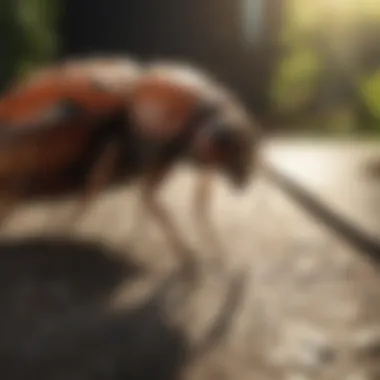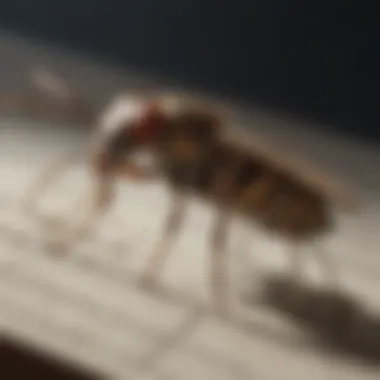Mastering General Pest Control: A Comprehensive Guide


Preventive Pest Control Strategies
To begin the journey towards a pest-free environment, we must first fortify our defenses with proactive measures. House exterior protection serves as the initial line of defense. By meticulously sealing cracks and crevices, clearing debris, and implementing barriers to prevent pest intrusion, we create a formidable shield against unwanted guests from the outdoors. When it comes to yard maintenance, adopting essential routines and employing effective methods to keep the yard pest-free are paramount to safeguarding our outdoor spaces. Moving indoors, a focus on cleanliness is crucial. Expert cleaning tips and techniques not only enhance the living environment but also serve as a deterrent to pests, maintaining an indoor space that is resistant to infestations. Proper garbage disposal practices play a significant role in thwarting pest attractions. Efficient waste disposal methods not only contribute to a clean living environment but also eliminate potential food sources for pests. Additionally, incorporating innovative strategies beyond the conventional norms can provide added layers of protection, ensuring comprehensive coverage against various pests.
Identifying Pest Risk Areas
With preventive measures in place, the next step is to identify potential risk areas within and around our homes. Conducting inspections in moisture-prone areas is critical. By identifying damp conditions and implementing preventive measures, we can counter the allure of these areas to pests. Crack and crevice inspection is equally essential. Understanding the significance of inspecting access points and employing strategies to seal them off helps in denying pests easy entry into our living spaces. Greenery inspection plays a vital role in assessing the impact of plants on pest activities. By adhering to guidelines for maintaining a pest-free yard, we create an inhospitable environment for pests to thrive. Moreover, identifying miscellaneous pest risk areas and implementing suitable preventive measures round up our comprehensive approach to risk identification.
Effective Pest Control Methods
Transitioning from prevention to intervention, effective pest control methods become pivotal in managing existing infestations. Employing natural repellents offers a safe and eco-friendly solution. Utilizing essential oils, herbs, and plants not only repels pests effectively but also minimizes the environmental impact of pest control measures. For more robust interventions, chemical sprays can be utilized following safe usage guidelines to eradicate pests swiftly. Pest traps serve as another effective control method. Setting up traps strategically and ensuring safe capture and removal of pests help in curbing their presence within our living spaces. Embracing biological control methods involves leveraging natural predators to manage pest populations, promoting environmentally friendly pest control practices. Exploring innovative pest control methods beyond the traditional ones opens up avenues for tailored solutions to varied pest challenges.
Pest Species Identification
Enhancing our pest control efficacy requires a keen understanding of common pests that invade our living spaces. Recognizing common insects like ants, cockroaches, and spiders aids in implementing targeted control measures. Identifying rodents such as mice and rats is crucial for preventing costly infestations and health hazards. Addressing bird-related issues that impact our homes involves understanding troublesome bird species and taking appropriate action to mitigate their presence. Dealing with wildlife encounters necessitates effective control measures to safeguard both property and inhabitants. Managing lesser-known pests effectively enhances our overall pest control efficacy.
DIY Pest Control Techniques
As empowered homeowners, incorporating do-it-yourself pest control techniques empowers us to proactively manage pest issues. Creating homemade pest control solutions using eco-friendly remedies offers a sustainable approach to pest management. Harnessing the repellent properties of essential oils provides a natural barrier against pests, promoting a bug-free home environment. Implementing effective pest traps and barriers further fortifies our defenses, preventing and controlling infestations efficiently. Exploring reputable pest control brands equips us with quality products for home pest management, ensuring reliable solutions for our pest control needs. Unveiling miscellaneous DIY pest control techniques unveils a spectrum of unique solutions tailored to specific pest challenges, strengthening our arsenal against unwelcome intruders.
Understanding General Pest Control
Pest control plays a crucial role in maintaining a healthy and hygienic living environment. Understanding general pest control is essential in preventing infestations and ensuring the well-being of households. This section explores the various aspects of pest control, from identifying common pests to implementing effective strategies for eradication. By delving into the significance of pest management and the contributions of professional pest control agencies, individuals can safeguard their homes against the harmful effects of infestations.
Definition of Pest Control
Importance of Pest Management
The importance of pest management lies in its ability to address pest infestations proactively, reducing the risk of property damage and health hazards. By utilizing preventive measures and strategic interventions, pest management contributes significantly to maintaining a pest-free environment. One of the key characteristics of pest management is its focus on long-term solutions, which ensure sustained protection against pests. While the unique feature of pest management is its eco-friendly nature, minimizing the use of harmful chemicals and promoting sustainable practices. This approach provides numerous advantages in terms of efficacy and safety, making it a preferred choice for households seeking reliable pest control solutions.
Role of Pest Control Agencies


Pest control agencies play a vital role in providing specialized services for the identification and elimination of pests. Their expertise in handling various pest species and implementing tailored control measures is instrumental in combating infestations effectively. The key characteristic of pest control agencies is their in-depth knowledge of pest behaviors and habitats, allowing them to devise targeted strategies for pest eradication. Their unique feature lies in the use of advanced technologies and industry-best practices, ensuring efficient and thorough pest control services. While the advantages of opting for pest control agencies include time-saving solutions, expertise-driven interventions, and comprehensive pest management, it is essential to consider potential disadvantages such as cost implications and reliance on external services.
Common Pests
Types of Household Pests
Household pests encompass a wide range of common insects and rodents that pose threats to residential spaces. Understanding the characteristics and habits of household pests is crucial in implementing appropriate control measures. Common household pests such as cockroaches, rodents, and ants are known for their ability to contaminate food, spread diseases, and damage property. By addressing these pests promptly through effective control methods, homeowners can mitigate the risks associated with infestations. The unique feature of household pest control is its emphasis on integrated approaches, combining preventive measures with targeted treatments for maximum effectiveness. While the advantages of controlling household pests include enhanced hygiene, reduced health risks, and property protection, it is essential to be aware of potential disadvantages such as recurring infestations and the need for ongoing maintenance.
Garden Pests to Watch Out For
Preventive Measures
Preventive measures play a crucial role in maintaining pest-free environments. By implementing proactive strategies, individuals can prevent infestations and minimize the risks associated with pests. In this section, we will explore the significance of preventive measures, focusing on key elements that contribute to effective pest control.
Maintaining Hygiene
Effective pest control begins with maintaining proper hygiene practices within and around living spaces. The importance of cleanliness cannot be overstated when it comes to deterring pests. Clean surroundings not only discourage pests from taking residence but also help in early detection of any potential infestations. Regular cleaning routines, proper waste disposal, and sanitation practices are essential factors in preventing pest problems.
Importance of Cleanliness
The aspect of cleanliness is a fundamental pillar in pest control efforts. A clean and well-maintained environment creates an inhospitable setting for pests, reducing their attraction to the area. Regular cleaning routines significantly diminish the chances of pest infestations by eliminating potential food sources and hiding spots for pests. Moreover, cleanliness promotes a healthy living environment for occupants, mitigating health risks associated with pests. : cleanliness The meticulous practice of cleanliness is a key component in the battle against pests, often serving as a first line of defense. By upholding high standards of cleanliness, individuals can effectively deter pests from infiltrating their homes and businesses, ensuring a hygienic and pest-free environment.
Food Storage Practices
Proper food storage practices are essential in minimizing pest access to nutrition sources. By securely storing food items in airtight containers and promptly disposing of perishable items, individuals can prevent pests such as rodents and insects from being attracted to the premises. Ensuring that food storage areas are regularly cleaned and inspected adds an extra layer of protection against potential infestations.
Structural Repairs
Structural integrity plays a vital role in pest control by sealing off potential entry points for pests. Repairing gaps, cracks, and crevices in buildings prevents pests from infiltrating living spaces, thus reducing the likelihood of infestations. In this section, we will delve into the importance of structural repairs and how they contribute to pest management.
Sealing Cracks and Gaps


Sealing cracks and gaps in walls, foundations, and windows is an effective way to block pest entry. By addressing these vulnerabilities, individuals can fortify their homes against unwanted intruders. Proper sealing not only prevents pests from entering but also enhances energy efficiency and structural durability.
Repairing Leaky Pipes
Leaky pipes not only lead to water wastage but also attract pests that thrive in moist environments. Repairing leaky pipes not only conserves water but also eliminates conditions suitable for pest infestations. By promptly fixing plumbing issues, individuals can safeguard their properties from water damage and pest problems.
Landscaping Techniques
Outdoor spaces can harbor pests that may eventually infiltrate indoor areas. Implementing effective landscaping techniques can deter pests from taking refuge in gardens and yards, minimizing the risk of infestations. In this section, we will discuss the role of landscaping in pest control and explore strategies to maintain pest-free outdoor environments.
Natural Plant Repellents
Planting natural repellent plants around the perimeter of a property can act as a natural barrier against pests. Certain plants possess odors or properties that repel common pests, serving as a sustainable pest control method. Utilizing natural plant repellents not only enhances the aesthetic appeal of the landscape but also discourages pests from establishing nests nearby.
Proper Drainage Systems
Effective drainage systems are essential in preventing water accumulation, which can attract pests like mosquitoes and rodents. Properly designed drainage systems ensure water flows away from structures, reducing the likelihood of moisture-related pest issues. Maintaining functional drainage systems protects properties from water damage and minimizes the risk of pest infestations.
This detailed exploration of preventive measures underscores the proactive approach individuals can take to safeguard their properties against pests. By prioritizing hygiene, structural integrity, and landscaping considerations, individuals can create inhospitable environments for pests while promoting overall well-being and sustainability.
Effective Pest Control Methods
Effective Pest Control Methods play a crucial role in maintaining a pest-free environment. Deploying the right methods can effectively address pest infestations and prevent future occurrences. In this section, we will explore various strategies to combat pests effectively. From chemical treatments to biological control and integrated pest management, each method offers distinct advantages worth considering for comprehensive pest control.
Chemical Treatments
Insecticides and Pesticides
Insecticides and pesticides are integral components of pest control strategies. These chemical agents are designed to target and eliminate specific pests, ensuring effective mitigation of infestations. The key characteristic of insecticides and pesticides lies in their ability to swiftly eradicate pest populations, offering a rapid solution to pest problems. While these chemical treatments are popular for their efficacy, they come with considerations regarding environmental impact and human health. It is essential to carefully follow application guidelines to minimize risks associated with chemical exposure.
Application Techniques


Effective application techniques are essential for maximizing the benefits of chemical treatments. Proper application ensures that insecticides and pesticides are distributed accurately, targeting pest-infested areas effectively. The key characteristic of precise application lies in its ability to enhance the efficiency of chemical treatments, allowing for thorough coverage of affected spaces. However, incorrect application methods can result in inefficient pest control and potential overexposure to harmful chemicals. It is imperative to adhere to recommended application procedures to achieve optimal results while prioritizing safety and environmental preservation.
Biological Control
Beneficial Predators
Biological control methods, such as beneficial predators, offer a natural and eco-friendly approach to pest management. Beneficial predators, such as certain insects and animals, actively prey on pests, helping to regulate their populations without the use of chemicals. The key characteristic of beneficial predators is their ability to establish a balanced ecosystem by controlling pest numbers naturally. This method is favored for its sustainable nature and minimal environmental impact. However, certain challenges may arise, such as the need to introduce and maintain predator populations in targeted areas.
Microbial Insecticides
Microbial insecticides utilize specific microorganisms to combat pest infestations. These biological control agents target pests at a microscopic level, disrupting their physiological functions and reproductive cycles. The key characteristic of microbial insecticides is their selective action, which focuses on specific pests while preserving beneficial organisms. This targeted approach minimizes environmental harm and supports ecosystem balance. Despite their eco-friendly nature, microbial insecticides require precise application and monitoring to ensure effectiveness and avoid unintended consequences.
Integrated Pest Management
Holistic Approaches
Integrated pest management techniques adopt a holistic approach to pest control, emphasizing prevention, monitoring, and intervention strategies. By combining various control methods, including cultural, biological, and chemical solutions, this approach minimizes reliance on single tactics, promoting sustainable pest management practices. The key characteristic of holistic approaches is their comprehensive nature, addressing pest issues through a multifaceted strategy that considers ecological, economic, and social factors. While integrated pest management offers long-term benefits and reduces environmental risks, it requires ongoing monitoring and adaptive strategies to maintain effectiveness.
Monitoring and Inspection
Monitoring and inspection are pivotal elements of integrated pest management, enabling the accurate assessment of pest levels and infestation trends. Regular monitoring helps identify early signs of pest activity, allowing for prompt intervention to prevent widespread infestations. The key characteristic of monitoring and inspection lies in their proactive nature, facilitating targeted responses based on real-time data analysis. By monitoring pest populations and inspecting vulnerable areas, homeowners can address pest issues efficiently and proactively. However, consistent monitoring demands time and attention to detail, ensuring the efficacy of integrated pest management practices.
Professional Pest Control Services
Professional pest control services play a pivotal role in ensuring a pest-free environment within residential and commercial spaces. These services encompass a wide array of specialized techniques and approaches aimed at efficiently eradicating pests while minimizing environmental risks. By entrusting professionals with the task of pest management, individuals can benefit from expert knowledge, innovative solutions, and tailored strategies that address specific pest infestations. The significance of professional pest control services lies in their ability to not only eliminate existing pests but also prevent future infestations through comprehensive treatment plans.
Role of Exterminators
Exterminators, forming the backbone of professional pest control services, are highly trained individuals responsible for executing pest management strategies with precision and effectiveness. Their role in the pest control process is multifaceted, beginning with meticulous inspection procedures designed to identify the type and extent of infestation. Through thorough inspections, exterminators can pinpoint vulnerable areas, assess pest behavior, and develop strategic action plans to combat the issue at hand. Customized treatment plans tailored to the specific needs of each situation are then meticulously implemented, utilizing a combination of pest control methods calibrated for maximum efficacy.
Certifications and Accreditation
Certifications and accreditation serve as key indicators of a pest control service provider's credibility, expertise, and commitment to industry standards. Industry certifications validate the proficiency of exterminators and the company as a whole, ensuring that they adhere to best practices and regulations. By upholding industry standards, pest control agencies demonstrate their dedication to quality service delivery and customer satisfaction. Additionally, eco-friendly practices integrated into pest control operations not only reduce environmental impact but also contribute to sustainable pest management solutions that prioritize human health and ecological balance.
Follow-up Maintenance
Sustaining a pest-free environment necessitates diligent follow-up maintenance, a critical component of long-term pest control success. Monitoring infestation levels post-treatment allows exterminators to track the effectiveness of interventions, identify any residual pest activity, and make necessary adjustments to ensure complete eradication. By closely monitoring infestation levels, pest control professionals can optimize treatment strategies and provide timely responses to emerging pest threats. Ensuring long-term results involves preventative measures, ongoing assessment, and strategic interventions to fortify properties against future pest incursions, safeguarding the well-being of occupants and preserving the integrity of the environment.



